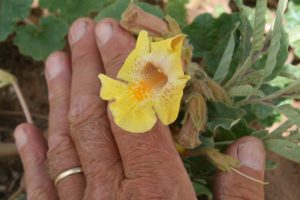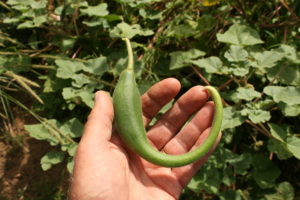 Who hasn’t gotten hooked by a dry devils claw pod on a walk in the borderlands. So pesky and yet so interesting looking, it’s the kind of pod that begs to end up on a mantle or book shelf or god forbid some macramé. And though I want it to be, devils claw is not exclusive to the southwest. There are around 9 species of Proboscidea found around America as far east as Delaware. Other common names for the genus are unicorn flower or unicorn plant.
Who hasn’t gotten hooked by a dry devils claw pod on a walk in the borderlands. So pesky and yet so interesting looking, it’s the kind of pod that begs to end up on a mantle or book shelf or god forbid some macramé. And though I want it to be, devils claw is not exclusive to the southwest. There are around 9 species of Proboscidea found around America as far east as Delaware. Other common names for the genus are unicorn flower or unicorn plant.
The genus Proboscidea is from the Greek for elephant trunk and refers to the long beak of the fruit (That’s the part that dries out and splits and hooks onto you or your dog. See the photo). There are two species listed for Arizona. Proboscidea parviflora is a common annual and best known for the large dry fruit being used as a dark fiber in Native American basketry. The young fruit is edible and the seeds of the dry fruit are edible as well if you feel like prying it apart for a snack. Some pliers and a nut pick would be handy.
Proboscidea altheaefolia is our perennial devil’s claw, returning each year from the roots and it is the species with an amazing sweet floral fragrance. And if the fragrance isn’t enough, the flowers are simply beautiful. They are quite large, but you’ll still need to get down on your hands and knees to see them in the mound of green sticky leaves. You won’t regret it.



I love Toumey oaks…I know, I said that, but we have several planted at our little homestead. I think if I lived in and...

I was reading a Christmas card from some very dear friends and in the hand written portion of the card it mentioned this season...

The Ol’ Guajolote came flowing out of the mountains down to the grassland and Petey found himself tumbling downstream with his dog Farley. A...